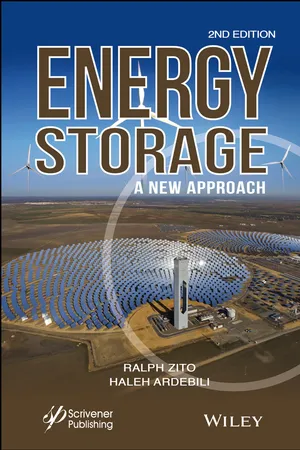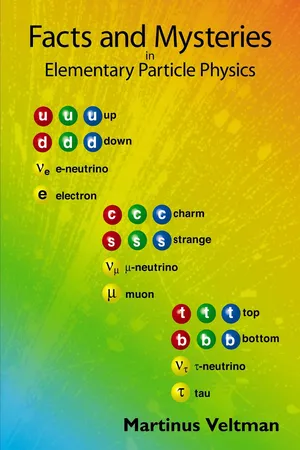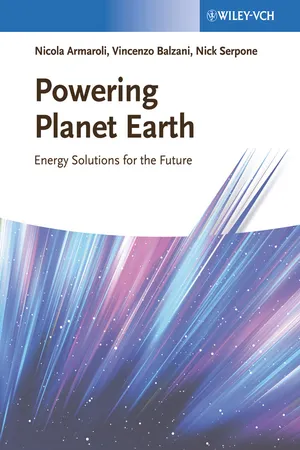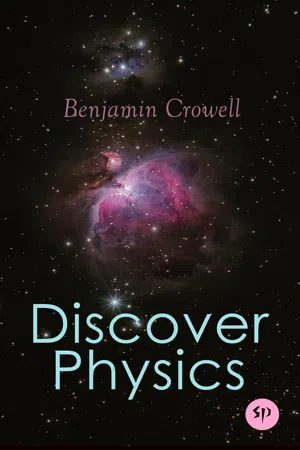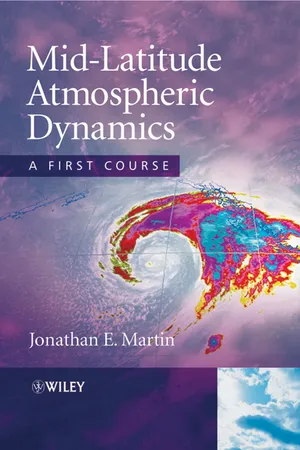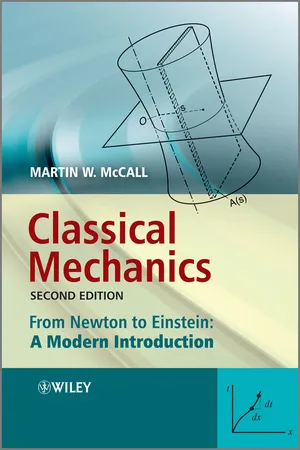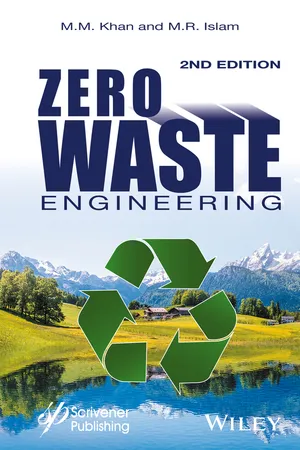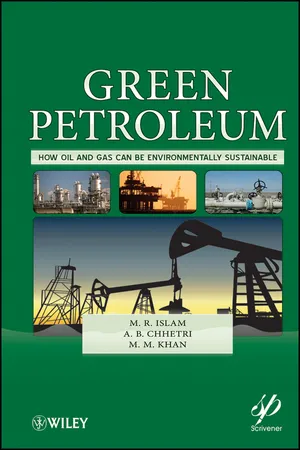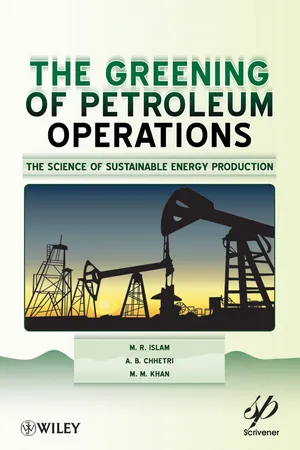Physics
Mass and Energy
Mass and energy are fundamental concepts in physics. Mass refers to the amount of matter in an object, while energy is the ability to do work. According to Einstein's theory of relativity, mass and energy are interchangeable, as expressed by the famous equation E=mc^2, where E is energy, m is mass, and c is the speed of light.
Written by Perlego with AI-assistance
Related key terms
Related key terms
1 of 4
Related key terms
1 of 3
10 Key excerpts on "Mass and Energy"
- eBook - ePub
Energy Storage
A New Approach
- Ralph Zito, Haleh Ardebili(Authors)
- 2019(Publication Date)
- Wiley-Scrivener(Publisher)
In more recent times, the idea has taken hold that energy is some ethereal form of substance. In quantum and relativistic mechanics, energy is interchangeable with mass (matter) as indicated, for example, in the celebrated equation from Einstein’s Relativity Theory, E = mc 2. Kinetic energy remains kinetic energy when, for example, a moving mass slows down by frictional losses. The collective kinetic energy of the mass is disbursed as kinetic energy (motion) of many more, smaller particles (molecules) and measured as a temperature rise. However, kinetic energy can be converted or swapped for potential energy when, for example, a mass loses velocity while slowing down as it moves against an attractive field of force such as gravity. In more recent times, the idea has taken hold that energy is a substance. For those who wish to acquire a detailed knowledge of the history of the concept of energy and force, including the evolution of these concepts over the centuries, the books Concepts of Mass and Concepts of Force by Max Jammer would be helpful. As far as we know, consistent with our observations, energy cannot be created or destroyed. We will ignore, in this book, the processes wherein energy and matter are equivalent, i.e., that matter can be transformed into energy and vice versa because all the phenomena associated with our lives do not occur at the atomic nuclear level. The availability of energy to do work can and does change. We can only transform energy from one of its two forms into the other, when possible, to suit our practical purposes, such as from kinetic energy to potential energy and back to kinetic. Ultimately, all these transformations resolve in an increase of entropy (disorder) in the universe and, therefore, an increase in world temperature - Martinus J G Veltman(Author)
- 2003(Publication Date)
- WSPC(Publisher)
2 . Indeed it is in particle physics that some very remarkable aspects of the theory of relativity are most clearly demonstrated, not just the energy-mass equation. Another example is the lifetime of unstable particles, in particular the muon. The lifetime of a moving muon appears to be longer in the laboratory, in accordance with the time dilatation predicted by the theory of relativity.Thus the mass-energy must be included when considering the relation between energy and momentum. The figure shows the relation between energy and momentum for two different particles, respectively with masses m and M . We have taken M three times as large as m . For zero momentum the energy is simply mc 2 for the particle of mass m and Mc 2 for the particle of mass M .This figure is really the all-important thing in this Chapter. Understanding it well is quite essential, since we shall draw a number of conclusions from it. In itself it is simple: the curve shows the relation between momentum and energy for a single particle. Given the momentum of a particle of mass m one can find the corresponding energy by using the curve for mass m . If the momentum is zero then the energy is mc 2 .In drawing the figure one must make a choice of units. We have drawn a figure corresponding to a choice of units such that the speed of light is one. For very large positive or negative momenta energy becomes very nearly equal to the magnitude of the momentum. In the figure that we have drawn the diagonal lines represent the relation energy = ± momentum. The curves approach these diagonal lines for large momenta. The diagonal lines define the light cone; the reason for that name shall become obvious soon.- eBook - ePub
Powering Planet Earth
Energy Solutions for the Future
- Nicola Armaroli, Vincenzo Balzani, Nick Serpone(Authors)
- 2012(Publication Date)
- Wiley-VCH(Publisher)
For nearly 5 billion years, the Sun has converted 4.4 billion tonnes of hydrogen every second into electromagnetic energy through nuclear fusion processes at temperatures well above 10 million degrees. A tiny fraction of this endless energy flux lightens our days. Of course, Einstein’s equation also suggests that it is possible to convert energy into mass. This has been verified by means of some very complicated experiments. It is possible to create new particles of matter by concentrating huge amounts of energy into a small volume of space.From Kilowatt-hour to the Barrel of Oil
Units of measurement are the despair of many High School, College, and University students. There are some units that are common and easily understood by all. Others are more difficult to digest. The so-called international system of units (SI) defines the unit of measurement of seven physical quantities: length is measured in meters (m), time in seconds (s), mass in kilograms (kg), temperature in degrees kelvin (K), amount of a substance in moles (mol), electrical current in amperes (A), and light intensity in candelas (cd).All other physical quantities, strange as it may seem, are a combination of these seven units of measure. Some sadistic science teachers like to see students cringe when told that electrical resistance has something to do with kilograms, or that heat capacity has something to do with meters. Many students never understand this and forever drop their scientific studies.As we had anticipated, energy is not a primary physical concept. It may seem bizarre that, from this point of view, electricity and light intensity are both hierarchically superior to energy, but that’s the way it is, folks.We have already stated that work can be expressed as the product of force multiplied by distance - eBook - ePub
- Benjamin Crowell(Author)
- 2018(Publication Date)
- Studium Publishing(Publisher)
You’ve encountered two conservation laws so far: conservation of mass and conservation of energy. If conservation of energy is a consequence of symmetry, is there a deeper reason for conservation of mass? Actually they’re not even separate conservation laws. Albert Einstein found, as a consequence of his theory of relativity, that Mass and Energy are equivalent, and are not separately conserved — one can be converted into the other. Imagine that a magician waves his wand, and changes a bowl of dirt into a bowl of lettuce. You’d be impressed, because you were expecting that both dirt and lettuce would be conserved quantities. Neither one can be made to vanish, or to appear out of thin air. However, there are processes that can change one into the other. A farmer changes dirt into lettuce, and a compost heap changes lettuce into dirt. At the most fundamental level, lettuce and dirt aren’t really different things at all; they’re just collections of the same kinds of atoms—carbon, hydrogen, and so on.We won’t examine relativity in detail until chapter 6, but mass-energy equivalence is an inevitable implication of the theory, and it’s the only part of the theory that most people have heard of, via the famous equation E = mc2 . This equation tells us how much energy is equivalent to how much mass: the conversion factor is the square of the speed of light, c. Since c a big number, you get a really really big number when you multiply it by itself to get c2 . This means that even a small amount of mass is equivalent to a very large amount of energy.Gravity bending lightexample 10Gravity is a universal attraction between things that have mass, and since the energy in a beam of light is equivalent to a some very small amount of mass, we expect that light will be affected by gravity, although the effect should be very small. The first experimental confirmation of relativity came in 1919 when stars next to the sun during a solar eclipse were observed to have shifted a little from their ordinary position. (If there was no eclipse, the glare of the sun would prevent the stars from being observed.) Starlight had been deflected by the sun’s gravity. Figure r - eBook - ePub
Information and the World Stage
From Philosophy to Science, the World of Forms and Communications
- Bernard Dugué(Author)
- 2017(Publication Date)
- Wiley-ISTE(Publisher)
The new interpretation taking shape at the moment splits physics into two categories: mechanics of arrangements and dynamics of information. The former dominates classical physics and the latter concretizes itself with the quantum theory of matter. Electromagnetic physics has remained ambiguous. It uses classic notions, fields and their influences (Coulomb, Maxwell), but the processes that it describes are not classic in the mechanical sense. The natural world in which we are evolving includes two kinds of forces, namely those whose essence is mechanical and those linked to electric charges. It is a strange nomological coincidence that the formula of electrostatic force is similar to that of gravitation. The first is proportional to the product of the two electric charges, q1 and q2. The second is proportional to the product of the masses, m1 and m2. The two are inversely proportional to the square of the distance. The fundamental difference is that gravitation attracts, whereas electric force attracts or repels according to whether the charges have identical or opposed signs.Mass is not reduced to a gravitational force which, incidentally, is not an actual force. We also know inertial mass. However, regardless of the nature of mass, we are dealing with a physics of forces, a type of mechanics and a science of arrangements. Cosmology studies the arrangement of masses in the universe. Rational mechanics studies several types of phenomena, such as how masses clash and transmit to one another a part of energy or impulse. Inertia designates nothing more than the resistance of a mass against any force attempting to move it. Hence, the formula that calculates the acceleration g based on the force F applied to a mass m is F = mg. Rational mechanics also studies another type of movement that differs from translation, namely rotation. Once again, in this case, the inertial mass is opposed to any force aiming to make a solid turn. In physics, mass is a property of matter that describes how material elements are arranged in space and opposed to forces (whichever their origin), and also how they generate forces such as gravitation forces.4.2. Electric charge, spin and dynamics of information
- eBook - ePub
Mid-Latitude Atmospheric Dynamics
A First Course
- Jonathan E. Martin(Author)
- 2013(Publication Date)
- Wiley(Publisher)
3Mass, Momentum, and Energy: The Fundamental Quantities of the Physical World
Objectives
Study of the physical world tends to be focused on the quantities known as mass, momentum, and energy. The behavior of the atmosphere is no exception to this rule. In this chapter we will investigate the manner in which these quantities and their various interactions serve to describe the building blocks of a dynamical understanding of the atmosphere at middle latitudes. We must first consider the distribution of mass in the atmosphere and the force balance that underlies this distribution. A number of insights concerning the vertical structure of the atmosphere proceed directly from this understanding.Beginning with Newton’s second law, we will construct expressions for the conservation of momentum in the three Cartesian directions. These expressions are commonly known as the equations of motion and will serve as the fundamental set of physical relationships for all subsequent inquiry in this book. Scale analysis of the horizontal equations of motion will reveal that a simple diagnostic relationship between the mass and momentum fields, geostrophy, characterizes the mid-latitude atmosphere on Earth. Finally, employing these equations of motion we will develop expressions for the conservation of mass and the conservation of energy. We begin by considering the distribution of mass in the atmosphere.3.1 Mass in the Atmosphere
For our purposes, we shall define mass as the measure of the substance of an object and make that measurement in kilograms (kg). Though it was not clear to ancient thinkers like Aristotle,1 the atmosphere has mass. In fact the Earth’s atmosphere has a mass of 5.265 × 1018 - eBook - ePub
Classical Mechanics
From Newton to Einstein: A Modern Introduction
- Martin W. McCall(Author)
- 2011(Publication Date)
- Wiley(Publisher)
are already accounted for once it is established experimentally that the rest mass and momentum of an isolated system are conserved. The conservation of energy has a higher objective status in relativity.Why doesn’t the rest energy matter in Newtonian physics? For a particle moving with speed v we could include a rest energy term and write for a free particle(6.19)Applying energy conservation to the elastic collision of two particles would then lead to the equation(6.20)which is of course the same as Equation (4.19 ) since the rest energy terms cancel. The rest terms still cancel in calculating the loss of kinetic energy in inelastic collisions. However, in both cases there is no implication for the total system mass, which is given by m 1 + m 2 . In Newtonian physics there is no coupling between the loss of energy and the total system mass, and we simply say that the energy is converted to heat. Relativistically, however, the total rest mass of two moving particles is always greater than the individual rest masses. When two particles collide head on and stick together and are then at rest in the lab frame, their total mass is still greater than m 1 + m 2 , the excess accounting for the loss of kinetic energy. All of this works provided the rest mass of the particles is included in the calculation .The argument works in reverse. A stationary massive particle which disintegrates into two smaller particles which fly apart must liberate some of the energy which held it together to provide kinetic energy to the fragments . This is the basis of nuclear fission, in which the binding energy of a large nucleus is released as kinetic energy of the fragments after it has disintegrated. Every body has the potential to provide energy to fragments into which it might disintegrate, and this potentiality is the rest energy, E rest = mc 2 - eBook - ePub
Zero Waste Engineering
A New Era of Sustainable Technology Development
- M. M. Khan, M. R. Islam(Authors)
- 2016(Publication Date)
- Wiley-Scrivener(Publisher)
–9 gram. Because no attention is given to the source of the matter nor of the pathway, the information regarding these two important intangibles is wiped out from the conventional scientific analysis. The fact that a great amount of energy is released from a nuclear bomb is then taken as evidence that the theory is correct. By accepting this at face value (heat as a one-dimensional criterion), heat from nuclear energy, electrical energy, electromagnetic irradiation, fossil fuel burning, wood burning or solar energy, becomes identical.In terms of the well-known laws of conservation of mass (m), energy (E) and momentum (p), the overall balance, B, within Nature may be defined as some function of all of them:(4.1)The ‘perfection-without-stasis’ that is Nature means that everything that remains in balance within it is constantly improving with time. That is:(4.2)If the proposed process has all concerned elements so that each element is following this pathway, none of the remaining elements of the mass balance discussed later will present any difficulties. Because the final product is being considered as time extends to infinity, the positive (“>0”) direction is assured.4.3 Continuity of Matter and Phase Transition
By introducing time-spans of examination unrelated to anything characteristic of the phenomenon itself being observed in nature, discontinuities appear. These are entirely removable, but they appear to the observer as finite limits of the phenomenon itself, and as a result, the possibility that these discontinuities are removable is not even considered. This is particularly problematic when it comes to the matter of phase transitions of matter and the renewability or non-renewability of energy. - eBook - ePub
Green Petroleum
How Oil and Gas Can Be Environmentally Sustainable
- M. R. Islam, A. B. Chhetri, M. M. Khan(Authors)
- 2012(Publication Date)
- Wiley-Scrivener(Publisher)
On the one hand, in a Newtonian mechanical system, time-duration remains tied to the motion of a mass inside a referential frame of active forces. On the other hand, momentum is preserved at all scales, from the most cosmic to the nano- and inter-atomic level, and at none of these scales can time or motion stop. Although Newton posited gravitation as a universally acting force, we now know that electromagnetic forces predominate in matter at the nano- or inter-atomic level. Electromagnetic forces, like frictional forces, can exist and persist without ever having been externally applied. Reasoning thus “by exhaustion,” Newton’s three laws of motion plus the principle of universal gravitation are actually special cases of “something else.” That “something else” is far more general, like the universal preservation of mass-energy balance and conservation of momentum. The connecting glue of this balance that we call nature is that motion is the mode of existence of all matter. This is what renders time a characteristic of matter within the overall context of mass-energy-momentum conservation.By considering motion as the mode of existence of all matter, it also becomes possible at last to treat time, consistently, as a true fourth dimension, and no longer as merely the independent variable. In other words, time ceases to be mainly or only a derivative of some spatial displacement of matter. Also, if time is characteristic of matter (rather than characteristic particularly or only of its spatial displacement), then transformation of matter’s characteristic scale must entail similarly transforming the scale on which time and its roles are accounted.From this, it follows as well that whatever we use to measure time cannot be defined as fixed, rigid, or constant, e.g., a standard like the “second,” or selected or imposed without regard to the reference-frame of the phenomenon under observation. It is possible to assign physical meaning to ∂s/∂t - eBook - ePub
The Greening of Petroleum Operations
The Science of Sustainable Energy Production
- M. R. Islam, A. B. Chhetri, M. M. Khan(Authors)
- 2011(Publication Date)
- Wiley-Scrivener(Publisher)
On the one hand, in a Newtonian mechanical system, time-duration remains tied to the motion of a mass inside a referential frame of active forces. On the other hand, momentum is preserved at all scales, from the most cosmic to the nano- and inter-atomic level, and at none of these scales can time or motion stop. Although Newton posited gravitation as a universally acting force, we now know that electromagnetic forces predominate in matter at the nano- or inter-atomic level. Electromagnetic forces, like frictional forces, can exist and persist without ever having been externally applied. Reasoning thus “by exhaustion,” Newton’s Three Laws of Motion plus the principle of universal gravitation are actually special cases of “something else.” That “something else” is far more general, like the universal preservation of mass-energy balance and conservation of momentum. The connecting glue of this balance that we call nature is that motion is the mode of existence of all matter. This is what renders time a characteristic of matter within the overall context of mass-energy-momentum conservation.By considering motion as the mode of existence of all matter, it also becomes possible at last to treat time, consistently, as a true fourth dimension and no longer as merely the independent variable. In other words, time ceases to be mainly or only a derivative of some spatial displacement of matter. Also, if time is characteristic of matter (rather than characteristic particularly or only of its spatial displacement), then transformation of matter’s characteristic scale must entail similarly transforming the scale on which time and its roles are accounted.From this, it follows as well that whatever we use to measure time cannot be defined as fixed, rigid, or constant, e.g., a standard like the “second,” or selected or imposed without regard to the reference-frame of the phenomenon under observation. It is possible to assign physical meaning to ∂s/∂t
Index pages curate the most relevant extracts from our library of academic textbooks. They’ve been created using an in-house natural language model (NLM), each adding context and meaning to key research topics.
Explore more topic indexes
Explore more topic indexes
1 of 6
Explore more topic indexes
1 of 4
